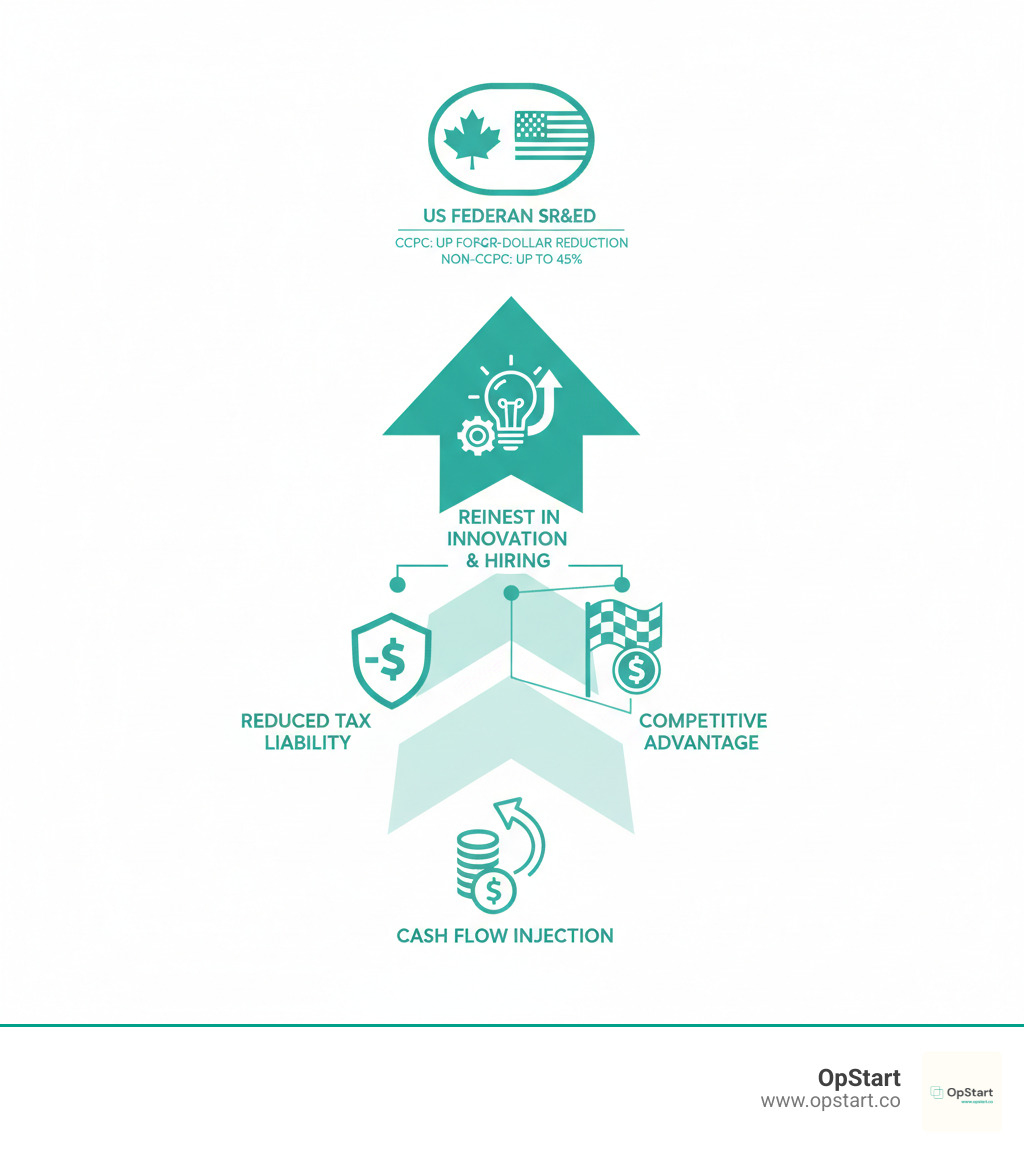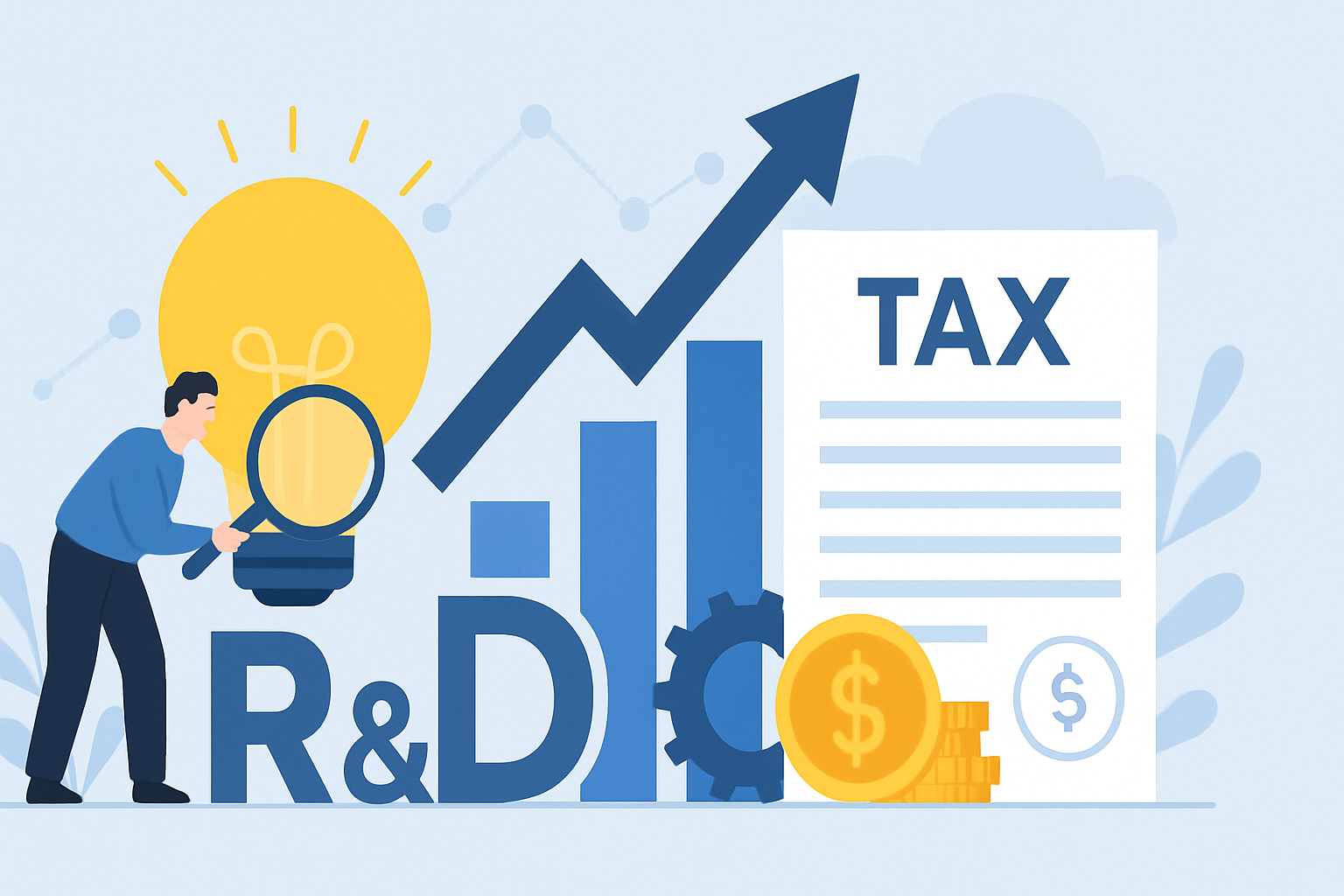Why R&D Tax Services Could Be Your Best Investment This Year
R&D tax services help businesses claim valuable tax credits for innovation work you’re already doing—whether that’s developing new software, improving manufacturing processes, or creating prototypes. These specialized services identify qualifying activities, calculate your credit, prepare documentation, and support you through audits.
Key benefits of working with R&D tax service providers:
- Maximize your claim – Experts identify all eligible activities and expenditures you might miss
- Save time – They handle data collection, technical narratives, and form filing
- Reduce audit risk – Professional documentation and support if the IRS or CRA comes knocking
- Access federal and state/provincial credits – Steer complex multi-jurisdiction rules
- Claim prior years – Many providers help amend returns to capture missed credits from past 3 years
The numbers are significant. In Canada, the SR&ED program can equal up to 68% of qualifying R&D expenses for Canadian-controlled private corporations. In the US, the federal credit offers a dollar-for-dollar reduction of taxes owed, with approximately 38 states offering additional incentives. More than $3 billion in tax incentives flow through these programs annually.
Yet many founders leave money on the table. Your accountant might think you don’t qualify. You might assume R&D credits are only for “high-tech” companies with labs. Or you’re simply too busy scaling your business to steer the complex qualification rules.
That’s where R&D tax services come in. These specialists combine technical expertise with tax knowledge to ensure you claim every dollar you’re entitled to—without the headache of doing it yourself.
I’m Maurina Venturelli, and throughout my career scaling companies like Sumo Logic and LiveAction, I’ve seen how strategic use of r&d tax services can free up capital for growth. At OpStart, we help fast-growing startups steer exactly these kinds of financial opportunities.

What Are R&D Tax Credits and Why Do They Matter?
R&D tax credits are government incentives designed to reward businesses for innovation. Whether you’re developing new software, improving a manufacturing process, or building prototypes, these credits offer a significant financial benefit by providing a dollar-for-dollar reduction in your tax liability. This isn’t a mere deduction; it’s a direct cut to your tax bill, creating a powerful incentive to invest in growth.
In the US, the federal research credit offers this direct reduction, while Canada’s Scientific Research & Experimental Development (SR&ED) program can return up to 68% of qualifying expenses for Canadian-Controlled Private Corporations (CCPCs). Annually, billions of dollars are distributed through these programs, fueling economic growth.
For startups and growing companies, these credits can be transformative. Refundable credits, particularly prevalent in Canada, can result in a direct cash payment, even if your company isn’t yet profitable. In the US, the payroll tax offset allows eligible small businesses to apply the credit against their Social Security tax liability—a huge advantage for pre-revenue startups with development teams. This injection of capital can be reinvested directly into your business, funding future projects, hiring key talent, or upgrading equipment, ultimately boosting your company’s valuation.
More info about our Comprehensive R&D Services
Startup Accounting Services: What Founders Need to Know
Who is Eligible? A Breakdown for US & Canadian Businesses
One of the biggest misconceptions about R&D tax credits is that they are only for large corporations with dedicated research labs. In reality, these incentives are designed for businesses of all sizes, from startups to established companies, across nearly every industry. If your company is working to solve technical challenges, you may be eligible.
Eligibility in the United States
In the US, eligibility for the federal R&D tax credit is determined by a “four-part test.” Your project or activity must meet all four criteria:
- Permitted Purpose: The goal must be to create a new or improved product, process, software, or formula.
- Elimination of Uncertainty: You must be attempting to resolve a technical uncertainty at the outset of the project.
- Process of Experimentation: You must engage in a systematic process of evaluation, such as modeling, simulation, or trial and error.
- Technological in Nature: The work must be based on principles of the hard sciences, like engineering, computer science, or biology.
This framework covers a wide range of activities, including software development, new product prototyping, and manufacturing process improvements.
More info on Startup Taxes for Startups
Eligibility in Canada (SR&ED Program)
Canada’s Scientific Research and Experimental Development (SR&D) program is one of the most generous R&D tax credit programs globally. To qualify, your work must meet three key criteria:
- Scientific or Technological Advancement: The work must aim to advance the understanding of technology or science.
- Technological Uncertainty: You must be facing a technological problem that cannot be resolved by standard practice.
- Systematic Investigation: The work must be a systematic investigation conducted through experiment or analysis to overcome the uncertainty.
This program is particularly beneficial for Canadian-Controlled Private Corporations (CCPCs), which can receive a refundable tax credit of up to 35% on the first $3 million of qualified expenditures. Many provinces also offer their own R&D incentives.
Guide to claiming the Alberta Innovation Employment Grant
[TABLE] Comparing US and Canadian R&D Tax Credits
| Feature | United States (Federal R&D Tax Credit) | Canada (SR&ED Program) |
|---|---|---|
| Credit Type | Generally non-refundable; startups may offset payroll taxes under PATH Act provisions | Refundable for CCPCs (up to 35%); non-refundable for others (15%) |
| Qualifying Expenditures | Wages for qualified research, supplies, contract research (65% of costs), cloud computing costs | Wages, materials, third-party contracts (80% of costs), overhead allowance, capital equipment (in some cases) |
| Documentation Style | Technical narrative explaining the four-part test; contemporaneous records; Form 6765 | Detailed technical and financial documentation; Form T661; project descriptions with scientific/technological advancement |
| Federal vs. State/Provincial Credits | Federal credit plus separate state credits in ~38 states, each with own rules | Federal SR&ED credit plus separate provincial/territorial credits that often align with federal rules |
What Are R&D Tax Credits and Why Do They Matter?
R&D tax credits reward companies for innovating. They provide a dollar-for-dollar reduction of tax liability in the US and, in Canada, generous SR&ED incentives that can return up to 68% of qualifying expenses for CCPCs (and up to 45% for others). Billions flow through these programs annually, creating a virtuous cycle: innovate, claim credits, reinvest, and repeat.
More info about our Comprehensive R&D Services
The Financial Impact on Your Business
Refundable credits (common in Canada) can put cash in your account even if you’re not profitable. In the US, eligible startups can offset payroll (Social Security) taxes, which is especially valuable for pre-revenue teams with engineers and developers. Many businesses see strong ROI from professional help with claims, enabling reinvestment into product, hiring, and runway.
Startup Accounting Services: What Founders Need to Know
Fueling Innovation and Growth
Credits help you hire technical staff, purchase equipment, and expand research capabilities—accelerating timelines and strengthening your competitive position. Governments created these programs to spur domestic innovation, making them a cornerstone of long-term financial strategy for startups.
Who is Eligible? A Breakdown for US & Canadian Businesses
R&D incentives are not just for large corporations with research labs. Startups, small businesses, and mid-market companies across many industries can qualify if they are tackling technical challenges through systematic experimentation. Everyday problem-solving that advances or improves products, processes, or software often qualifies.
Eligibility in the United States
To qualify for the federal R&D tax credit, activities generally must meet the four-part test:
- Permitted Purpose: Creating or improving a product, process, software, formula, or technique.
- Elimination of Uncertainty: Addressing uncertainty about capability, methodology, or design.
- Technological in Nature: Relying on principles of engineering, physics, chemistry, biology, or computer science.
- Process of Experimentation: Systematically evaluating alternatives (e.g., testing, modeling, simulation, iteration).
Common qualifying activities include:
- Developing or improving products and processes
- Creating new software, applications, or algorithms
- Engineering custom solutions and tooling
- Prototyping and first-article design
- Testing new materials or configurations
More info on Startup Taxes for Startups
Eligibility in Canada (SR&ED Program)
Canada’s SR&ED program supports basic research, applied research, and experimental development. Qualifying work typically demonstrates:
- Scientific or Technological Advancement
- Technological Uncertainty
- Systematic Investigation via experiment or analysis
CCPCs can receive a refundable ITC at an improved rate of 35% on the first $3 million of qualified expenditures. Many provinces offer additional incentives that often align with SR&ED rules (e.g., Alberta’s Innovation Employment Grant).
Guide to claiming the Alberta Innovation Employment Grant
[TABLE] Comparing US and Canadian R&D Tax Credits
| Feature | United States (Federal R&D Tax Credit) | Canada (SR&ED Program) |
|---|---|---|
| Credit Type | Generally non-refundable; startups may offset payroll taxes under PATH Act provisions | Refundable for CCPCs (up to 35%); non-refundable for others (15%) |
| Qualifying Expenditures | Wages for qualified research, supplies, contract research (typically 65% of costs), cloud computing costs | Wages, materials, third-party contracts (80% of costs), overhead allowance, and provincial add-ons |
| Documentation Style | Technical narrative explaining the four-part test; contemporaneous records; Form 6765 | Detailed technical and financial documentation; Form T661; project descriptions demonstrating advancement and uncertainty |
| Federal vs. State/Provincial Credits | Federal credit plus separate state credits in ~38 states | Federal SR&ED credit plus separate provincial/territorial credits |
Identifying Qualifying Activities and Expenditures
Understanding what activities and costs qualify is crucial for a successful R&D tax credit claim. It’s not just about groundbreaking scientific findies—it’s about systematic efforts to resolve technological uncertainties.

Professional R&D tax services excel at identifying opportunities that might otherwise go unnoticed, from direct wages to materials consumed and third-party contractor costs.
What Activities Qualify for R&D Tax Credits?
Many everyday business activities qualify if you’re undertaking systematic efforts to develop or improve a product, process, technique, invention, formula, or software. When your team faces a technical challenge where the solution isn’t obvious and they’re systematically experimenting to figure it out, that’s R&D in action.
Common qualifying activities include:
- Developing new products or processes – Creating new machinery in manufacturing or novel service delivery methods
- Improving existing products – Making them faster, more efficient, reliable, or adding significant new features requiring technical problem-solving
- Developing prototypes or models – Creating experimental versions or simulations to test concepts, even failed experiments
- Creating new software or algorithms – Building proprietary software, developing apps, or designing complex algorithms
- Engineering custom solutions – Designing and fabricating unique tools, dies, or equipment for specific technical challenges
- Testing new materials – Experimenting with different substances or components to achieve desired outcomes
- Configuring existing technologies in new ways – Taking established tech and innovating its application for novel purposes
Activities in skilled trades like welding, fabrication, and coating can involve R&D when performed to overcome technological uncertainties. Using CAD, BIM, or design modeling software for experimental purposes also qualifies. Even building self-constructed assets with technical uncertainty can be eligible.
The key is that these activities must involve technological uncertainty and a process of experimentation to resolve it. Your team doesn’t need lab coats—they just need to be systematically solving technical problems where the answer wasn’t readily available.
What Expenditures Can You Claim?
Once you’ve identified qualifying R&D activities, pinpoint the associated expenditures. Getting this right is crucial, and it’s where expert r&d tax services prove their worth by ensuring you capture every eligible dollar.
Employee wages (W-2) usually represent the biggest category—salaries, wages, and compensation paid to employees directly engaged in, supervising, or supporting qualified research activities. For most companies, this is the largest component of their claim.
Raw materials and supplies are costs for tangible property used and consumed in the R&D process—ingredients for new food products, chemicals for experiments, prototype components, or testing materials.
Cloud computing costs have become crucial in our digital world. While not explicitly mentioned in older regulations, modern interpretations increasingly recognize cloud infrastructure as an essential “supply” for software R&D.
Third-party contractor costs qualify when you outsource specialized tasks or engage consultants to perform qualified research on your behalf—common when you need specific expertise not available in-house.
Patent costs occupy a special category. While not always a direct R&D expenditure, certain costs associated with obtaining patents for qualified research can sometimes be included.
Important note: A significant recent change in the US is the requirement under Section 174 (effective for tax years beginning after December 31, 2021) to capitalize and amortize specified R&D costs rather than expensing them immediately, including software development costs. While this doesn’t impact the credit calculation itself, it affects how these costs are treated on your income statement and can substantially impact cash flow. This complexity is exactly why working with specialized R&D tax services makes such a difference.
More info on Business Startup Tax Deductions
Navigating the Claim Process with R&D Tax Services
Engaging professional R&D tax services is often the smartest move for navigating the intricate rules and documentation requirements of R&D tax credits. These experts translate complex tax jargon into actionable steps, ensuring you don’t leave money on the table.
From initial assessment to audit preparation, a dedicated R&D tax services provider streamlines the entire process—identifying eligible projects, collecting data, crafting technical narratives, and calculating your credit with precision.
The Typical Engagement Process with a Provider
A typical engagement follows a structured approach designed to minimize disruption:
- Initial Assessment & Free Consultation: Brief discussion of your operations and projects to determine preliminary eligibility and estimate potential credit
- Project Identification: Working with technical teams through interviews to identify all potential R&D projects meeting eligibility criteria
- Data Collection: Gathering financial and technical documentation including payroll records, project notes, and research results
- Technical Narrative Writing: Translating technical activities into clear narratives demonstrating how work meets R&D tax credit criteria
- Credit Calculation: Calculating qualified research expenses and resulting R&D tax credit amount
- Claim Filing: Preparing necessary tax forms (like Form 6765 in the US) and ensuring correct submission
- Audit Support: Providing comprehensive audit protection and expert representation if your claim is questioned
Our team at OpStart works closely with your internal tax team or CPA throughout this process, ensuring seamless coordination and accurate credit calculations ready for filing deadlines.
More info on our Startup Tax Firm
How to Maximize Your Claim with professional r&d tax services
Maximizing your R&D tax credit claim requires a thorough, systematic approach where professional R&D tax services ensure you capture every entitled dollar:
- Contemporaneous Documentation: Tax authorities want evidence that R&D efforts were planned and documented as they happened. We help establish ongoing documentation processes.
- Leveraging Project Tracking Systems: Integrating with tools like Jira, GitHub, or Azure DevOps to extract valuable data serving as excellent contemporaneous documentation.
- Identifying All Eligible Projects: Uncovering hidden gems—activities businesses didn’t realize qualified.
- Accurate Cost Segregation: Properly categorizing and allocating costs to ensure only eligible costs are included and none missed.
- Looking Back at Prior Years: Claiming R&D credits for prior tax years still open by statute (generally past 3 years in the US) can represent significant windfalls.
- Proactive Claim Preparation: Continuous identification of eligible R&D work throughout product development makes future claims easier and more robust.
More info on Startup Tax Filing
Preparing for Audits with expert r&d tax services
While claiming the R&D credit won’t necessarily trigger an audit, it’s prudent to be prepared. Professional R&D tax services are built with audit defense in mind:
- Robust Documentation is Key: Comprehensive, audit-ready documentation with all project narratives, financial data, and supporting evidence carefully organized.
- Digital Audit Binder: Centralized, secure repository of all R&D documentation ensuring transparency and easy information production if requested.
- Expert Representation: Full support and expert representation during an audit—we stand behind our work, answer questions, and defend your claim.
- Audit Success Rates: Reputable providers report over 98% of claims delivered without audit, and when audits occur, they recover up to 95% of estimated claims.
By partnering with expert R&D tax services, you’re getting both filing help and a shield against potential scrutiny, ensuring your hard-earned credits are secure.
More info on Six Tax Land Mines for Startups
The Modern R&D Landscape: Changes, Tech, and Myths
The world of R&D tax credits is dynamic, with evolving legislation and technology. Staying informed is crucial to maximizing your benefits and avoiding costly pitfalls.
Recent Legislative Changes You Should Know
A significant change in the US is the requirement under Section 174 to capitalize and amortize R&D costs over five years (or 15 for foreign research), rather than expensing them immediately. This impacts your taxable income and cash flow, making expert tax planning more critical than ever. Additionally, the IRS now requires more detailed documentation on Form 6765, increasing the administrative burden for filers.
Expect heavy lift from new R&D credit form
The Role of AI and Technology in Claims
Modern R&D tax services leverage technology to streamline the claims process. AI-powered platforms can integrate with your existing project management tools (like Jira or GitHub) to automatically identify qualifying activities and expenses. This not only reduces the administrative burden but also helps build a robust, audit-ready case file, ensuring you don’t miss out on any eligible credits.
Common Misconceptions Debunked
Many businesses miss out on R&D credits due to persistent myths. Let’s clear them up:
- “It’s only for high-tech companies.” False. Any industry, from manufacturing to software, can qualify if it’s solving technical problems.
- “My company is too small.” Not true. Startups and small businesses are major beneficiaries, with provisions like the payroll tax offset designed specifically for them.
- “It’s not worth the effort.” The return on investment is often significant, with many firms seeing a 5:1 return or more on the cost of professional services.
- “We’re not profitable, so it’s useless.” Incorrect. Credits can be carried forward, and some, like Canada’s SR&D credit for CCPCs or the US payroll tax offset, provide immediate cash flow benefits.
- “My CPA handles this.” While your CPA is essential, R&D tax credits are a specialized field. A dedicated expert can identify more opportunities and build a stronger, more defensible claim.
More info on Changes to the R&D Tax Credit: What Founders & CEOs Need to Know
Conclusion
We’ve journeyed through the intricate world of R&D tax credits, uncovering their significant benefits, understanding who qualifies in both the US and Canada, identifying eligible activities and expenditures, and navigating the complexities of the claim process. The key takeaway is clear: if your business is innovating, you’re likely leaving money on the table by not claiming these valuable credits.
These credits are more than just a tax break; they are a strategic financial tool that can inject cash flow, reduce your tax liability, and empower you to reinvest in the very innovation that drives your growth. Whether you’re a small startup developing cutting-edge software or a manufacturing company refining your production processes, the government wants to reward your efforts.
The landscape is dynamic, with legislative changes like Section 174 amortization in the US and the increasing role of AI in streamlining claims. This evolving environment makes expert guidance not just helpful, but essential. Professional R&D tax services ensure you’re compliant, your claim is maximized, and you’re prepared for any audits. They cut through the jargon, debunk common myths, and provide the peace of mind that comes from knowing you have seasoned experts in your corner.
At OpStart, we pride ourselves on providing comprehensive financial operations services for startups, including expert tax filings and CFO support. We understand the unique challenges and opportunities that fast-growing companies face. Our hands-free, expert-managed approach means you can focus on building your product and scaling your business, while we ensure you’re leveraging every possible financial advantage, including R&D tax credits. Don’t let complexity deter you; let us help you open up the full value of your innovation.



